外研社高一英语必修一unit1说课稿课堂
- 格式:ppt
- 大小:3.68 MB
- 文档页数:23
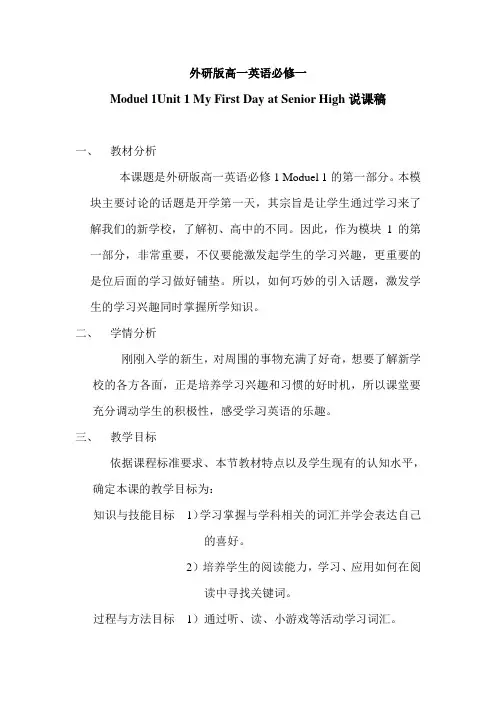
外研版高一英语必修一Moduel 1Unit 1 My First Day at Senior High说课稿一、教材分析本课题是外研版高一英语必修1 Moduel 1的第一部分。
本模块主要讨论的话题是开学第一天,其宗旨是让学生通过学习来了解我们的新学校,了解初、高中的不同。
因此,作为模块1的第一部分,非常重要,不仅要能激发起学生的学习兴趣,更重要的是位后面的学习做好铺垫。
所以,如何巧妙的引入话题,激发学生的学习兴趣同时掌握所学知识。
二、学情分析刚刚入学的新生,对周围的事物充满了好奇,想要了解新学校的各方各面,正是培养学习兴趣和习惯的好时机,所以课堂要充分调动学生的积极性,感受学习英语的乐趣。
三、教学目标依据课程标准要求、本节教材特点以及学生现有的认知水平,确定本课的教学目标为:知识与技能目标1)学习掌握与学科相关的词汇并学会表达自己的喜好。
2)培养学生的阅读能力,学习、应用如何在阅读中寻找关键词。
过程与方法目标1)通过听、读、小游戏等活动学习词汇。
2)小组活动完成对课文的分析。
情感态度与价值观目标通过这一课的学习,激发学习的积极性,克服部分同学学英语的畏难心理,为今后的学习打下好的基础。
教学重点、难点依据课程标准要求和本节教材实际,并结合学生的实际,本节课一是要兴趣为主,二是开始学习阅读方法。
由于初中对阅读方法的涉及不是很多,这一方面可能是刚开始接触,所以一定要把握好难易程度,这是本课的难点。
四、教学方法由身边的事物开始,通过游戏的方式让每个学生参与进来,有话可说,培养学习兴趣和主动性。
由分组讨论,激发动机,培养学生的学习积极性。
五、教学过程导入:In your new school, you must see many new things. Please find out some new things in our classroom……Introduction: 1)Say the names of your textbooks.2)Game: work in pairs. Do 1) again as quickly as youcan.3)Group your textbooks.4)Ask some students write their answers on theblackboard.5)Game.Reading:1)略读,找出各段大意。
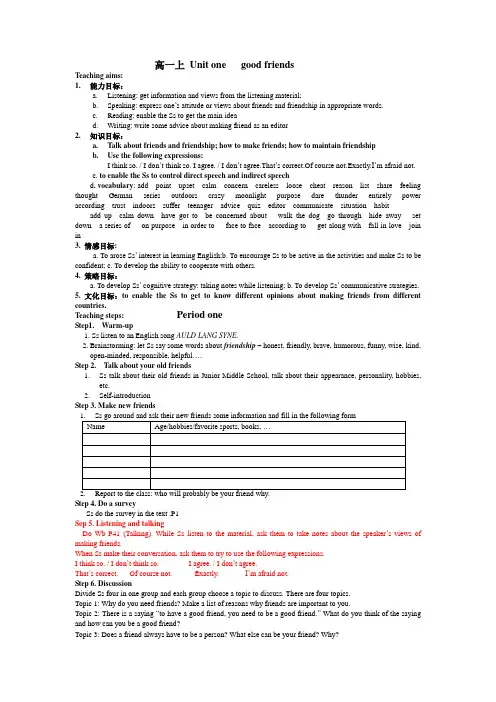
高一上Unit one good friendsTeaching aims:1.能力目标:a.Listening: get information and views from the listening material;b.Speaking: express one’s attitude or views about friends and friendship in appropriate words.c.Reading: enable the Ss to get the main idead.Writing: write some advice about making friend as an editor2.知识目标:a.Talk about friends and friendship; how to make friends; how to maintain friendshipe the following expressions:I think so. / I don’t think so. I agree. / I don’t agree.That’s correct.Of course not.Exactly.I’m afraid not.c. to enable the Ss to control direct speech and indirect speechd. vocabulary: add point upset calm concern careless loose cheat reason list share feeling thought German series outdoors crazy moonlight purpose dare thunder entirely power according trust indoors suffer teenager advice quiz editor communicate situation habit add up calm down have got to be concerned about walk the dog go through hide away set down a series of on purpose in order to face to face according to get along with fall in love join in3. 情感目标:a. To arose Ss’ interest in learning English;b. To encourage Ss to be active in the activities and make Ss to be confident;c. To develop the ability to cooperate with others.4. 策略目标:a. To develop Ss’ cognitive strategy: taking notes while listening;b. To develop Ss’ communicative strategies.5. 文化目标:to enable the Ss to get to know different opinions about making friends from different countries.Teaching steps: Period oneStep1. Warm-up1. Ss listen to an English song AULD LANG SYNE.2. Brainstorming: let Ss say some words about friendship – honest, friendly, brave, humorous, funny, wise, kind,open-minded, responsible, helpful….Step 2. Talk about your old friends1.Ss talk about their old friends in Junior Middle School, talk about their appearance, personality, hobbies,etc.2.Self-introductionStep 3. Make new friendsStep 4. Do a surveySs do the survey in the text ,P1Sep 5. Listening and talkingDo Wb P41 (Talking). While Ss listen to the material, ask them to take notes about the speaker’s views of making friends.When Ss make their conversation, ask them to try to use the following expressions.I think so. / I don’t think so. I agree. / I don’t agree.That’s correct. Of course not. Exactly. I’m afraid not.Step 6. DiscussionDivide Ss four in one group and each group choose a topic to discuss. There are four topics.Topic 1: Why do you need friends? Make a list of reasons why friends are important to you.Topic 2: There is a saying “to have a good friend, you need to be a good friend.” What do you think of the saying and how can you be a good friend?Topic 3: Does a friend always have to be a person? What else can be your friend? Why?Topic 4: List some qualities of a person who does not make friend easily. Step 7. Summary1. Ask Ss themselves to summarize what is friendship and what is the most important in making friends.2. T shows more information about friendship and a poem about friendship. What is friendship?3. Tell Ss: make new friends and keep the old; one is silver and the other is gold. Step 8. EvaluationHomework:1. Look up the new words and expressions in warm-up and pre-reading in a dictionary.2. Write a short passage about your best friend.Period two ReadingStep1.Warming upActivity1: Suppose you have to stay indoors to hide yourself for a whole year. You can never go outdoors, otherwise you will be killed. You have no telephone, computer, or Tv at home. How would you feel? What would you do?Four students a group discuss with each other for 2 minutes. Activity2: Play a short part of the movies Schindler’s List Step2. PredictingStudents read the title of the passage and observe the pictures and the outline of it to guess: Who is Anne’s best friend?What will happen in the passage? Step3. SkimmingStudents skim the passage in 2 minutes to get the main idea : Who is Anne’s best friend? When did the story happen? Step4. ScanningStudents work in pairs to find the information required below:AnneStudents work in group of four to discuss the following open questions: 1.Why did the windows stay closed? 2.How did Anne feel?3.What do you think of Anne?4.Guess the meanings of “spellbound”, “ hold me entirely in their power” from the discourse(语篇,上下文).5.Which sentences attract you in the passage? Step6. ActivityFour students a group to discuss the situation:Suppose you four have to hide yourselves for 3 months. During the three months, you will be offered the basic food, water and clothes. Your group can take 5 things with you.What will you take? Why? How will you spend the 3 months?How will you treat each other and make friends ?Step7.AssignmentTask1.Surf the internet to find An ne’s Diary and read some of it. Print out a piece of the diary and write down your feelings after reading it on the page. We will share the pieces and your feelings with the whole class.Task2.Ex2.3on Page3Period threeStep 1. Warming upCheck the Ss’ assignment: task 2Step 2. Language points:Step 3. Learning about language1.Finish Ex.1, 2 and 3. on Page 4.2.Direct speech and indirect speech: Ss do Ex.1 and 2 on Page 5. Then let the Ss themselves discover thestructures.Step 4. Practice Using structures on Page 42: ask the Ss to use indirect speech to retell the story.Step 5. Assignment Finish Wb. Ex, 1 and2 on page 41 and 42.Period fourStep 1. Revision Check the Ss’ assignment.Step 2. Reading Ss read the letter on page 6Notes:1.get along with2.fall in loveStep 3. ListeningSs should take notes while they are listning.1. first listening: Ss listen and answer the questions of part 2 on page 6.2. second listening: Ss listen again and finish part 3 on page 6.Step 4. ListeningSs listen to a story about Anne and try to finish Wb. Ex 1 and 2 on page 43 and page 44.Step 5. SpeakingSs work in groups of four. Design a questionnaire to find out what kind of friends your classmates are. They can use the quiz in the Warming up to help them.Step 6. Assignment1. Ss prepare the reading task on page 44.2. Surf the internet and find some material about friendship in different countries.Period fiveStep 1. Warming up Ss say something about making friends and how to maintain friendship.Step 2. Listening Ss listen to a short passage and fill in the blanks on page 41 (listening).Step 3. Reading1.first reading: Ss read the passage about friendship in Hawaii and finish Wb.Ex1.on page 45.2.second reading: Ss read again and discuss the questions on page 45.3.Ss share their material about friendship in different countries in groups, and then choose some groups toshow theirs in class.Step 4. Discussion What do you and your friends think is cool?Ss look at the photos on page 46 and in groups of four talk about whether what they are doing is cool or not .Ask Ss to use the following sentences while they talk:I think that… is cool/ isn’t cool because …. I think so. I don’t think so. I agree with you. I don’t agree with you. Step 5. assignment Ss collect some proverbs about friendship.Period sixStep 1. Pre-writing1.Read a letter from a student called Xiaodong.2.Go over the advice on page 7 and be ready for writing.Step 2. While-writingAsk the Ss to write a letter to Xiaodong as an editor and give him some advice.1.Ss make a list about the important information that they need.2.Ss begin to write the letter to Xiaodong.3.Ss revise their letters by themselves.4.Ss exchange their writing paper with their partners and correct the mistakes. (tense, spelling, letters,structures….)5.Ss get back their own writing paper and write the letter again.Step 3. Post-writingChoose some students’ writing paper and show in the class. Ask the Ss to correct the mistakes together and also learn from some good writings.Step 4. Writing for fun1.Ss read the passage on page 7 by themselves.2.Ss try to write a few lines to describe their best friends or a person they know.3.Show some Ss’ writings in class.Step 5.AssignmentDo Wb writing task on page 46.Period sevenTeachers can use this period freely.Suggestion: Teachers can use this period to let Ss sum up what they have learned and explain what Ss couldn’t understand very well in this unit. Teachers can also add more practice in this period to consolidate what the Ss have learned. Finally, ask the Ss to finish checking yourself on page 47. It is very important to improve their learning.。
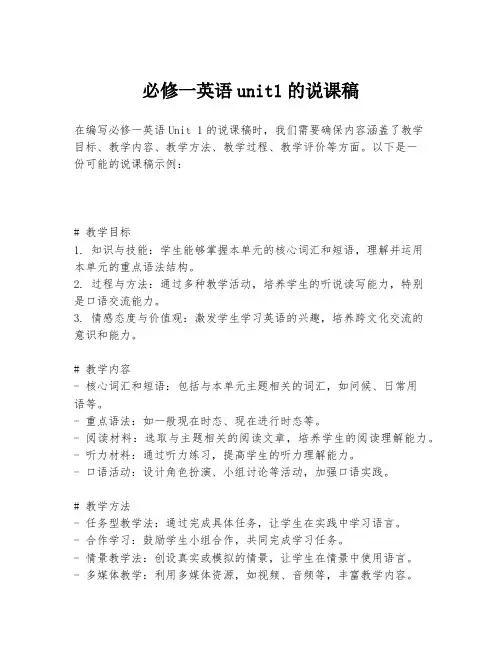
必修一英语unit1的说课稿在编写必修一英语Unit 1的说课稿时,我们需要确保内容涵盖了教学目标、教学内容、教学方法、教学过程、教学评价等方面。
以下是一份可能的说课稿示例:# 教学目标1. 知识与技能:学生能够掌握本单元的核心词汇和短语,理解并运用本单元的重点语法结构。
2. 过程与方法:通过多种教学活动,培养学生的听说读写能力,特别是口语交流能力。
3. 情感态度与价值观:激发学生学习英语的兴趣,培养跨文化交流的意识和能力。
# 教学内容- 核心词汇和短语:包括与本单元主题相关的词汇,如问候、日常用语等。
- 重点语法:如一般现在时态、现在进行时态等。
- 阅读材料:选取与主题相关的阅读文章,培养学生的阅读理解能力。
- 听力材料:通过听力练习,提高学生的听力理解能力。
- 口语活动:设计角色扮演、小组讨论等活动,加强口语实践。
# 教学方法- 任务型教学法:通过完成具体任务,让学生在实践中学习语言。
- 合作学习:鼓励学生小组合作,共同完成学习任务。
- 情景教学法:创设真实或模拟的情景,让学生在情景中使用语言。
- 多媒体教学:利用多媒体资源,如视频、音频等,丰富教学内容。
# 教学过程1. 导入新课:通过提问或展示图片,激发学生对本单元主题的兴趣。
2. 呈现新知:通过讲解、示范等方式,呈现本单元的新词汇和语法点。
3. 练习巩固:设计形式多样的练习,如填空、转换句型、角色扮演等,帮助学生巩固新知。
4. 应用实践:通过小组讨论、情景对话等活动,让学生在实际语境中运用所学知识。
5. 总结反馈:对学生的学习情况进行总结,并给予及时的反馈和评价。
# 教学评价- 形成性评价:通过课堂观察、口头提问等方式,了解学生的学习情况。
- 总结性评价:通过单元测试、作业检查等方式,评估学生对本单元知识的掌握程度。
# 教学资源- 教科书、练习册- 多媒体课件- 网络资源,如在线词典、英语学习网站等# 教学反思- 教学过程中应注意学生的反应,及时调整教学策略。

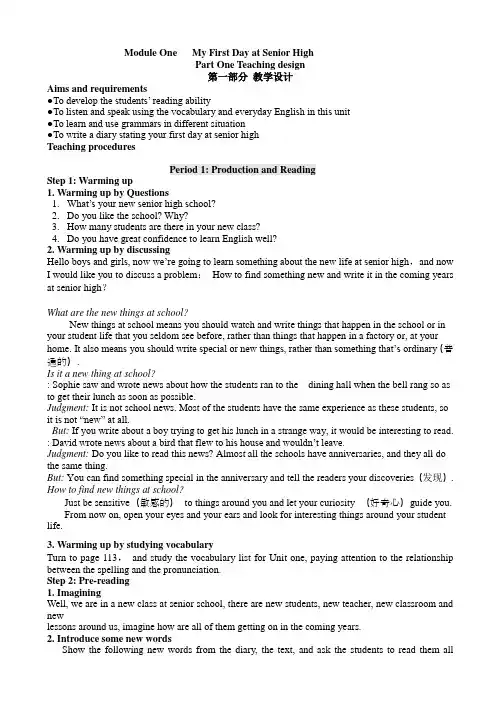
Module One My First Day at Senior HighPart One Teaching design第一部分教学设计Aims and requirements●To develop the students’ reading ability●To listen and speak using the vocabulary and everyday English in this unit●To learn and use grammars in different situation●To write a diary stating your first day at senior highTeaching proceduresPeriod 1: Production and ReadingStep 1: Warming up1. Warming up by Questions1.What’s your new senior high school?2.Do you like the school? Why?3.How many students are there in your new class?4.Do you have great confidence to learn English well?2. Warming up by discussingHello boys and girls, now we’re going to learn something about the new life at senior high,and now I would like you to discuss a problem:How to find something new and write it in the coming years at senior high?What are the new things at school?New things at school means you should watch and write things that happen in the school or in your student life that you seldom see before, rather than things that happen in a factory or, at your home. It also means you should write special or new things, rather than something that’s ordinary(普通的).Is it a new thing at school?: Sophie saw and wrote news about how the students ran to the dining hall when the bell rang so as to get their lunch as soon as possible.Judgment: It is not school news. Most of the students have the same experience as these students, so it is not “new” at all.But: If you write about a boy trying to get his lunch in a strange way, it would be interesting to read. : David wrote news about a bird that flew to his house and wouldn’t leave.Judgment: Do you like to read this news? Almost all the schools have anniversaries, and they all do the same thing.But: You can find something special in the anniversary and tell the readers your discoveries(发现). How to find new things at school?Just be sensitive(敏感的)to things around you and let your curiosity (好奇心)guide you.From now on, open your eyes and your ears and look for interesting things around your student life.3. Warming up by studying vocabularyTurn to page 113,and study the vocabulary list for Unit one, paying attention to the relationship between the spelling and the pronunciation.Step 2: Pre-reading1. ImaginingWell, we are in a new class at senior school, there are new students, new teacher, new classroom and newlessons around us, imagine how are all of them getting on in the coming years.2. Introduce some new wordsShow the following new words from the diary, the text, and ask the students to read them alltogether twice each word while correcting their pronunciation.Ok, we are to have a spelling quiz. Read every sentence and write out a word in the box above, using a proper form of the words.1)We may get much more i_______ from the Internet nowadays.2)I felt so a______ when I heard the news of the accident which happened yesterday.3)What’s your a______ to studying English this new term?4)They have got many m______ to solve this problem, don’t worry.5)Do you feel e______ when your friend refuses to lend you some money?6)I know little about the new machine, have you got any i______ when you buy it?( Keys: information, amazed, attitude, methods, embarrassed, instructions )Step 3: Reading1.Leading-inAfter discussing something about our class, our new school, we restudied some new words in this unit, maybe we think a new stage for a person, including a new school for a student, is not only fresh but also full of encouragement and challenge. I think, as long as you value the chance and work hard, success must belong to you. Now, let’s learn something about Li Kang’s sense at his first day at senior high. After reading, answer the following questions.1)Which city does Li Kang come from?2)What about his classrooms? What are there in the classrooms?3)Is his English teacher excellent? Why?4)What does Ms Shen want to do to help her students in English learning?5)How many students are there in the class?2.Fast reading for the general ideaKnowing Li Kang’s opinions about his new school, decide which of the following is the best.A.Li just likes his English teacher.B.Li not only likes his former school but his present one.C.Li describes his impression about his new class and English teacher.D.Li mainly introduced himself to his classmates.( Key: C )3.Listening to the tape of the text and try to find which of the following words appear in thestory.(Keys:enthusiastic, amazing, method, screen, friendly, handwriting, junior high school, looking forward to doing )4.Detailed reading for informationRead the following sentences and decide whether they are true (T) or false (F) according the text.1)Li Kang lives in our capital, Beijing.2)It is his first day at Junior High school.3)Li Kang knows why his new school is good.4)Ms. Shen is very enthusiastic woman to her students.5)Li Kang likes Ms. Shen’s attitude, but the others don’t.( Keys: 1 F 2 F 3 T 4 T 5 F )Step 4: Reading practiceRead the following passage within 5 minutes and make a better choice to each problem.One of the schools that offered me a full ride had an informal dinner one night in the spring. Considering my parents' financial difficulties, I decided to drive the 45 minutes and attend. At first, all I had planned to do was smile politely, eat free food, and listen quietly. But I surprised myself. At dinner the president of the university talked about the wonderful activities on campus including guest lectures and social gatherings. He also made it perfectly clear that free food would be offered at all future events. He continued with explanations of professors, he spoke, I began to realize that this school, though not as good as my first choice, might be the best one for me. It seemed meeting with many great programs. It seemed challenging yet caring.As the president ended his speech, we clapped politely and pushed back our chairs. As I walked out of that door, a feeling of comfort washed over me. Looking at the campus that night, I realized that I would be spending the next four years right there.In all honesty, my university is not as well-known as my "dream" university. However, it turned out to be the right choice of schools for me.1. How did the author feel when he started to read the letter?A. He was full of joy.B. He was lost in his dreamC. He was worried about the moneyD. He was uncertain which school to go to2. We can learn from the passage that the parents were ____.A. honestB. strictC. supportiveD. decisive3. In paragraph 5, "offered me a full ride" can be replaced by "____."A. would pay for transport to the schoolB. would show me around the campusC. would offer free meals at all eventsD. would charge me nothing for tuition4. What does the author mainly want to say?A. You second-choice college may actually be your best fit.B. You should consider comfort in your choice of schoolsC. You should try your best to attend your dream schoolD. Your choice of schools should be based on their fame.(Keys: 1.D 2.C 3.D 4.A)Step5:Homework1.Try to describe your classroom and your English teacher orally.2.Repeat the text.3.Learn the new words again using the dictionary if necessary.Module One My First Day at Senior HighPart One Teaching design第一部分教学设计Aims and requirements●To develop the students’ reading ability●To listen and speak using the vocabulary and everyday English in this unit●To learn and use grammars in different situation●To write a diary stating your first day at senior highTeaching proceduresPeriod Two: Grammar and usageStep 1:General introduction1.Revision of the present tenses.Warming upWarming up by reading, turn to page 4 and do the exercises.1)Read the sentences and answer the questions.2)Read the passage again. Choose 3 sentences in the present simple tense and two in the presentcontinuous tense. Say which uses they show.Summary about the present tenseWe’ve studied the present tenses in junior school in the past, let’s have a revision about the tenses in brief. When and where to use the present tenses is the most important point. Now, we have a conclusion:1)To denote present habitual action (表示现在习惯性行为)We go to school at seven o’clock every day.Bill often drinks heavily every night.2)To denote present state. (表示目前存在的状态)Honesty is the best policy to solve problems.Water consists of hydrogen and oxygen.3)To denote an objective truth.(表示客观真理)The earth is round and moves around the sun.Knowledge is power.4)To denote future actions sometimes.(有时指将来)I’ll let you know as soon as I hear from her.The plane leaves for Miami at eight o’clock tonight.The NMET tests (相关高考题):1)The house could fall down soon if no one ____ some quick repair works.A. has doneB. is doingC. doesD. had done2) Come and see me whenever ____.A. you are convenientB. you will be convenientC. it is convenient to youD. it will be convenient to you3) He will have learned English for eight years by the time he ____ from the university next year.A. will graduateB. will have graduatedC. graduatesD. is to graduate4) I ____ ping-pong quite well, but I haven’t had time to play since the new year.A. will playB. have playedC. playedD. play5) –-You are drinking too much.--Only at home. No one ____ me but you. (2000 北京)A. is seeingB. had seenC. seesD. saw( Keys: 1. C, 2. C, 3. C, 4. D 5. C )2. Adjectives ending in –ing and –edWarming up1) Warming up by reading My First Day at Senior High again and underline theadjectives with –ing or –ed endings.2) Warming up by choosingA.The –ing form describes characteristics of thingsB.The –ed form describes the characteristics of peopleC.The –ing form describes the people or things that cause the feelingD.The –ed form tells us how people feel( Keys: A B D )Summary about the usage of –ing and–ed.You may see the –ing or –ed forms of verbs from time to time in our reading materials used as adjectives as predicative to express the characteristics of something or somebody, but do you know which verbs they are? Now let’s have a selection:tire move excite worry bore surpriseencourage disappointed amaze interest pleaseamuse relax scare terrify puzzle astonishfrighten shock satisfy touchTheir regulation in usage can be shown in following patterns:sb. + be + -ed (the –ed form describes people)sth. + be + -ing(the –ing form describes things)The NMET tests(相关高考题):I used to play ping-pong a lot in my spare time, but now I’m interest ing in football. (1997 correcting test)(Key:interesting → interested)Step2: Exercises for consolidation1. Exercises for the present tense1.I ____ to have another try if I can get another chance.A. have been meaningB. meanC. am meaningD. meant2. ____ your broken leg.A. Do be careful ofB. Do care forC. Be carefulD. To be care full to3. It’s the third time that you ____ late for school this week.A. wereB. areC. had beenD. have been4. I won’t go home until I ____ the job.A. have doneB. had doneC. have beenD. are5. These kinds of shoes ____ well.A. don’t sellB. are not sellC. won’t be soldD. were not sold6. A quarrel ____ between the two neighbors.A. broke outB. was broken outC. is breaking outD. is broken out7. How long do you think the meeting ____ ?A. lastsB. will lastC. is lastedD. is lasting8. Our school yard ___ an area of 1,500 square meters.A. coversB. is coveredC. extendsD. is extended9. While this tough meat is being cooked, more water should ____ it.A. add toB. be added toC. had been added up toD. will be added to10. They left for Beijing last week and we ____ them so far.A. don’t hear fromB. didn’t hear fromC. haven’t heard fromD. won’t hear from11. You are very busy. I ____ you ____ hard for your experiment.A. suppose, are workingB. am supposing, are workingC. am supposing, workD. suppose, work12. My brother ____ a lot. He ____ a new novel at the moment.A. reads, readsB. reads, is readingC. is reading, is readingD. is reading, read13. Perhaps it will be a long time ____ from abroad.A. when Tom comes backB. when Tom will come backC. before Tome comes backD. that Tom comes back14. There ____ the bus. Harry up.A. is comingB. comeC. comesD. had come15. If you ____ over there for a moment, the manager will be here soon.A. will waitB. waitC. are waitingD. will be waiting( Keys: 1-5 BADAA 6-10 ABABC 11-15 ABCCA )2. Exercises for the participlesTranslate the following into English by using the–ing or –ed forms of verbs. They are used not only as predictive but also as complements of object, but the regulation is similar.1)你讲的这个事情很有意思。
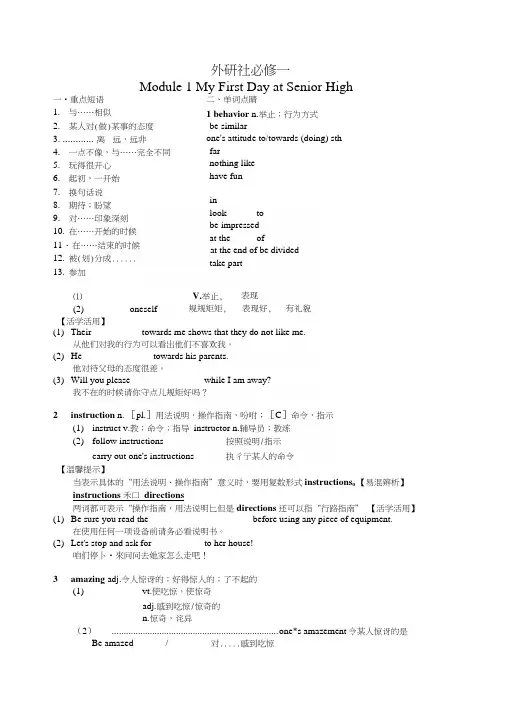
外研社必修一Module 1 My First Day at Senior High一•重点短语 1. 与……相似2. 某人对(做)某事的态度3. ............ 离 远,远非4. 一点不像,与……完全不同5. 玩得很开心6. 起初,一开始7. 换句话说8. 期待;盼望9. 对……印象深刻10. 在……开始的时候11・在……结束的时候12. 被(划)分成......13. 参加二、单词点睛1 behavior n.举止;行为方式 be similar ____ one's attitude to/towards (doing) sth far ____ nothing like have fun in __________ look _____ to be impressed ______ at the ____ of at the end of be divided take part _____(1) Their _________ towards me shows that they do not like me.从他们对我的行为可以看出他们不喜欢我。
(2) He ______________ towards his parents.他对待父母的态度很差。
(3) Will you please ______________ while I am away?我不在的时候请你守点儿规矩好吗?2 instruction n. [pl.]用法说明,操作指南,吩咐;[C ]命令,指示(1) instruct v.教;命令;指导 instructor n.辅导员;教练(2) follow instructions 按照说明/指示carry out one's instructions 执彳亍某人的命令【温馨提示】当表示具体的“用法说明、操作指南”意义时,要用复数形式instructions o 【易混辨析】instructions 禾口 directions两词都可表示“操作指南,用法说明匕但是directions 还可以指“行路指南” 【活学活用】(1) Be sure you read the ____________________ before using any piece of equipment.在使用任何一项设备前请务必看说明书。
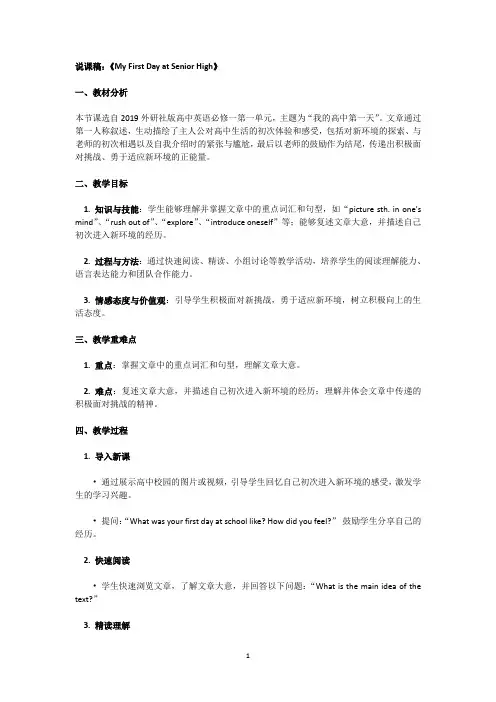
说课稿:《My First Day at Senior High》一、教材分析本节课选自2019外研社版高中英语必修一第一单元,主题为“我的高中第一天”。
文章通过第一人称叙述,生动描绘了主人公对高中生活的初次体验和感受,包括对新环境的探索、与老师的初次相遇以及自我介绍时的紧张与尴尬,最后以老师的鼓励作为结尾,传递出积极面对挑战、勇于适应新环境的正能量。
二、教学目标1. 知识与技能:学生能够理解并掌握文章中的重点词汇和句型,如“picture sth. in one's mind”、“rush out of”、“explore”、“introduce oneself”等;能够复述文章大意,并描述自己初次进入新环境的经历。
2. 过程与方法:通过快速阅读、精读、小组讨论等教学活动,培养学生的阅读理解能力、语言表达能力和团队合作能力。
3. 情感态度与价值观:引导学生积极面对新挑战,勇于适应新环境,树立积极向上的生活态度。
三、教学重难点1. 重点:掌握文章中的重点词汇和句型,理解文章大意。
2. 难点:复述文章大意,并描述自己初次进入新环境的经历;理解并体会文章中传递的积极面对挑战的精神。
四、教学过程1. 导入新课•通过展示高中校园的图片或视频,引导学生回忆自己初次进入新环境的感受,激发学生的学习兴趣。
•提问:“What was your first day at school like? How did you feel?”鼓励学生分享自己的经历。
2. 快速阅读•学生快速浏览文章,了解文章大意,并回答以下问题:“What is the main idea of the text?”3. 精读理解•学生分段精读文章,教师引导学生理解并掌握文章中的重点词汇和句型。
•提问:“What did the writer do when he/she arrived at the school? How did the writer feel when he/she met the teacher?”等问题,帮助学生深入理解文章内容。

Module One My first day at Senior highPeriod OneTeaching contenta)Self-introductionb)Vocabulary and speakingc)Everyday English and functionTeaching aims and demandsa)have the students to introduce themselvesb)have the students to know what you except from themc)have the students get familiar with some words of subjectsd)have the students to learn the Everyday English and functionTeaching methodsa)speaking b)discussing c)pair-work& group-workTeaching stepsStep1 Self-introduction(I) This is the first English class in Senior high, you are fresh to the students , so are the students. So it is necessary for you to introduce yourself to the students and get them to introduce them to you and other students , you must stress that the students must introduce them in English. If necessary, you can make an example first.eg : My name is Liyingxu , I am your new English teacher ,you can call me Mr.li. I was bornon April 16th in a small village in Hebei province. I graduated from Northwest Minorities University , I have taught English in this school for three years. I am a friendly teacher , I am usually ready to help everyone of you. I like sports very much ,but I am not good at it. I donmusic so much ,especially pop music, in my opinion, it is so noisy and meaningless. In my spare time, I like reading. I hope we can get along well with each other and I will try my best to teachyou how to learn English well more than the grammar & vocabulary & drills. I will be strict withevery student, so you must follow my words, or you will be punished.(some drills needed to be written on the black board)a)My name is ……b)I am a ……c)I was born on/in …… d)I graduated from ……e)I like/ am good at / am fond of ……f)I hope/ think/ want ……g)……(II) Get the students to introduce them to their partners in group of four, then ask some volunteers to introduce them to all the students in English. orAsk them to introduce them one by one.Step2 Vocabulary and speaking(I) V ocabularyAsk the students to tell you what subjects they learned in Junior High school and what othersubjects they will learn in Senior High school, ask the students to express them in English aspossible as they can, then write the words on the Bb, teach the students to pronounce thenow.words they don’t keg : Chinese English Mathematics Physics Chemistry Biology Politics HistoryGeography Arts Music IT (Information Technology) PE(Physical Education)GT(General Technology) Japanese Russian French(II)Dialogue (pair-work)T: How many subjects are science subjects?S: ……T: How many of them are languages?S: ……T: Which languages do you study at our school?S: .…..T: Which subjects do you like best? Why?S: ……Ask the students to imitate the dialogue to get which subject their partner like and why by using the following drills.Which subject do you like best? Why?Which subject do you like better between ...and …? Why?I like … because …I think … is important because …I would like to study/learn … because …In my opinion … is … so I …..Ask some of them to show their dialogues to the ss.Step 3 Everyday English and Function(I) T: After we have talked about the favorite subjects you like best, now lets turn toanother part. Every day when we have a break between classes we may meet some oldfriends, you may talk about your classes , now please turn to P8 , let’s learn the dialogu Everyday English and Function .Ask the students to listen to the tape ,then to read the dialogue in pairs. (explain somedifficult words and teach ask them to pronounce them by looking up them in the dictionary)Ask the students to read and analyze these sentences.1 How are you doing?2 Oh really?3 Is that right?(II) Work in pairs. Make a conversation about one of your classes . Use the conversationin activity 1 to help. Ask some of them to report and act their dialogue out.Step4 SummaryThe teacher summary the whole class for the students and tell them what they should do toimprove .HomeworkI Review the drills we learned in this class.II Preview Reading and vocabulary & Cultural corner.Period 2Teaching contenta) Reading and vocabularyb) Cultural cornerTeaching aims and demandsa)get the students to understand the texts wellb)get the students to know the school life in other schools ( at home and in the USA)c)help the students to improve their reading abilityTeaching methodsa) speaking b) reading c) discussing d) pair-work& group-workTeaching stepsStep 1 RevisionI Revise last class by ask them which subject they like best and why.II Revise everyday English by asking which class do you have before our English class andtalk about it with the help of Everyday English and Function on P8Step 2 Lead-in (Discuss and compare)T: Everybody , we have studied in a new school named Pingluo Middle School . Before youcome here , all of you studied in different schools, now I will give you some time to think what themain differences and similarities between Junior High school and Senior High school.And ask them to discuss these two problems:1 Do you think that work at Senior High school is harder than that at Junior High school?2 Are Senior High teachers similar to Junior High teachers?T: After we have compared Senior High school and Junior High school, now we will learnsomething about Likang’s First day at Senior High . before we read the text let’s learn som first.Step 3 VocabularyDeal with the vocabulary on P2 by finishing the questions in the part.Step 4 ReadingI ScanningRead the text quickly and try to find the answer to these questions:a)What are the differences between Likang’s Junior High school and Senior High school?b)What are the two things the English teacher thinks important to do in class?c)What are the two things that the English teacher want to improve?II UnderstandingPlay the tape for the students and ask them to listen & read following the tape in a low voice.Then finish the forth part in Reading and V ocabulary on P3.III Careful-readingAsk the students to read the passage again and find out which word in the box in the fifth partof Reading and Vocabulary on P4. And ask them try to guess the meaning and explain the words inEnglish according to the text.he new school in the Ask the students to read the three summaries of Likang’s opinion about tsixth part in Reading and V ocabulary on P4. Decide which is the best.IV DiscussionT: We have known the Likang’s life at Senior High, is your English classroom like Likangis your class the same size as his? Is the number of boys and girls the same? Are you lookingforward to doing your English homework? Now please discuss with your partner and compareyour school life with Likang’s.Step5 Cultural cornere life of theT: we have learned likang’s school life at senior high, do you want to know thteenagers in the similar age of you in other countries? Now please turn to P9, let’s read t cultural corner and learn something about the Senior High school life in the US.I Ask the students to listen to the tape and read the text.II Ask the students to answer the following questions:a)What are the differences between the grades in China and the US?b)How is the school year divided ?c)How long does the Summer Vacation last?d)When do they start and finish school?e)What do they do after school?III Ask the students to prepare a short reply to introduce the school system , vacation, studytime & after-school activities in China by imitating the letter in Cultural corner.Step6 SummaryThe teacher summary the class by comparing the school life in China and the US.Homework:I Write a reply to Rob MarshallII Read the text for as many times as they canIII Preview the language points in these two passages.Period 3Teaching contenta)the language points in the two passagesb)the important and difficult drills in the two passagesTeaching aims and demandsa)get the students to master some useful words or expressionsb)get the students to master some important drillsc)get the students to do some exercises about the language points.d)to improve the students ability of using EnglishTeaching methodsa)Explainingb)Discoveringc)PracticingTeaching stepsStep 1 RevisionRevise last class by checking home work and analyze the students’ replies. You can also ask some the students to read the good replies for the studentsStep 2 Language StudyI Underline the useful expressionsscience subject academic subjectbe similar to… differences between A and Bthe attitude to… teachingwrite down… on the computer onmethod a city not far from … the screeninformation from websites a woman called…. be nothing likespeak a lot in class have fun introduce oneselfin groups give sb instructions work by oneselfs spelling in a fun way in other wordsimprove one’s homework a description of look forward to doing… for one’be impressed with… A is the same size as B the number ofthe American school systems secondary schoolcover 7 years receive the high school diploma go to collegedivide….into.. September through December take part inbe free to do… without the help of sb become friendslast a long time There is a popular belief They say thathave similar life experiences under the same roof Thanks for doing…ask sb about… do experiments have dinnerstay on at school take a bus home school daybe fluent in Chinesespeak Chinese with fluency make a lot of progressat the beginning of write to sb all over the worldthe smell of paint the wall move to…have the biggest smileII Analyze the language pointsA)Words1 information noun facts or details telling sth about a situation, person ,event, etcinformation about/on sb/sth 关于某人/谋事的信息a piece of information 一则消息;一份情报ask for information on/about 打听关于……的消息 2 instruction n (pl) sth that sb tells you to do 指示(pl) information on how to do or use sth 说明follow the instructions for 遵守……的指示instructions on(how to do ) sth (如何做)某事的指示instructions to do sth 做某事的指示instructions遵照某人的指示on sb’be under instructions to do sth 被指示做某事instructions in 有关……的指示3 embarrassed adj. feeling nervous and uncomfortable and worryingbe embarrassed to do sth 羞于做某事be embarrassed about/at 对……感到困窘4 attitude n sb’s opinions of feelings about sth, especially as shown by theirbehaviourattitude to/towards sth/sb 对某人/某事的态度5 behaviour n way of treating others ; manners对……的态度/行为behaviour towards/to ……s good/best behaviour 循规蹈矩;行为检点be on one’put sb on his best behaviour 规劝/警告某人要规规矩矩6 previous adj happening or existing before the event or object you are talking about 以前的;从前的the previous day 前一天previous to 在……以前previously adv 以前;从前7 impress vt. to have a favourable effect on sb ; to make sb feel admiration and respectimpress sth in /on sthimpress sth on/opon sbimpress sb with sthbe impressed at/by/withimpression n.make an impression on sb8 cover vt to include or deal with sth 包含be covered by/ with被……所覆盖cover for sb 顶替某人cover (a distance) 走(一段距离)cover (sth new )报道(消息;新闻)cover sth up/over 盖住某物Step 3 PracticingAsk the students to do some exercises about the language points just learnedHomeworkI Remember the usages of the words todayII Preview and try to analyze the difficult sentences in these to passagesPeriod 4Teaching contenta) the language points in the two passagesb) the important and difficult drills in the two passagesTeaching aims and demandsa) get the students to master some useful words or expressionsb) get the students to master some important drillsc) get the students to do some exercises about the language points.d) to improve the students ability of using EnglishTeaching methodsa) Explainingb) Discoveringc) PracticingTeaching stepsStep 1 RevisionRevise the words learned yesterday by doing some translation exercises.(C to E or E to C).Step 2 language study1.The teacher is a very enthusiastic woman called Ms. Shen.这个非常热情的女老师是沈老师。

高一英语外研版必修book1and book2 说课稿B1 M1 My first day at senior high一教材内容本模块介绍一位高中新生第一天到校观察和接触到的人和事物,以及个人感受,内容紧密结合学生的现实生活,通过此部分的学习,使学生们通过课本所描述的生活对比感知自己高一第一天的生活,激发学习兴趣。
二学生分析学生刚进入高一学习,还不适应新的老师新的环境新的教学方法,更不适应高中全英语教学,很多学生存在胆怯害羞不敢开口的情况,所以老师上课时要通过问候,师生自我介绍等方式消除学生的害怕心理。
三教学重点难点1掌握重点词汇|、词组、及句型结构2比较一般现在时与现在进行时的用法3描述学校的情况四教学方法任务型教学法、情景教学法、交际教学法、启发式教学法五教学手段:多媒体教学六教学步骤Period 1 Introduction +listening +vocabularyPictures –words---listen1----listen2---act out更新时间:2012-05-19 20:36:00说课稿各位老师大家好,今天我说课的内容为外研社普通高中课程标准实验教学用书必修1,module3 My first ride on a train。
我上的是一堂听说课。
一教材分析::1.新教材特点介绍:高中必修阶段教材模块内容分为,Introduction, Reading and Vocabulary, Listening, Speaking, Writing, Grammar, Function, Everyday English, Pronunciation, Culture Corner, Task and Module File, 听说读写,词汇,语法等基本成对出线,各项技能均为综合性训练,注重语境化和语用化。
从模块内容上看,第一增加了Function, Everyday English 和 Pronunciation,这三部分是与模块听力或阅读材料有关的常见和典型的英语习惯用语。
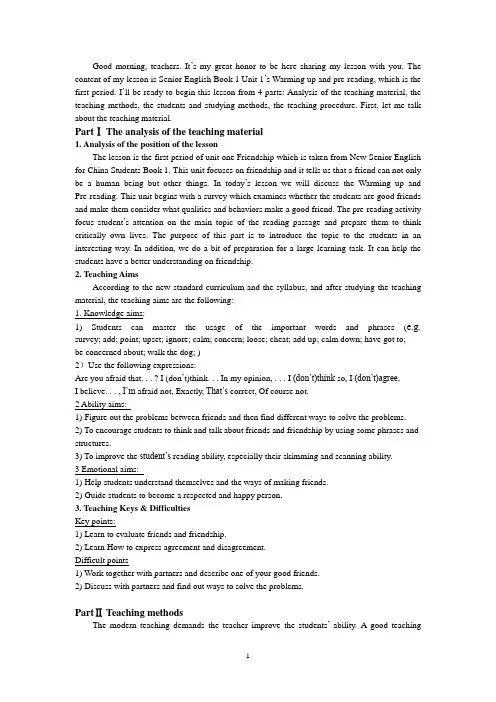
Good morning, teachers. It’s my great honor to be here sharing my lesson with you. The content of my lesson is Senior English Book 1 Unit 1’s Warming up and pre-reading, which is the first period. I’ll be ready to begin this lesson from 4 parts: Analysis of the teaching material, the teaching methods, the students and studying methods, the teaching procedure. First, let me talk about the teaching material.PartⅠ The analysis of the teaching material1. Analysis of the position of the lessonThe lesson is the first period of unit one Friendship which is taken from New Senior English for China Students Book 1. This unit focuses on friendship and it tells us that a friend can not only be a human being but other things. In today’s lesson we will discuss the Warming up and Pre-reading. This unit begins with a survey which examines whether the students are good friends and make them consider what qualities and behaviors make a good friend. The pre-reading activity focus student’s attention on the main topic of the reading passage and prepare them to think critically own lives. The purpose of this part is to introduce the topic to the students in an interesting way. In addition, we do a bit of preparation for a large learning task. It can help the students have a better understanding on friendship.2. Teaching AimsAccording to the new standard curriculum and the syllabus, and after studying the teaching material, the teaching aims are the following:1. Knowledge aims:1) Students can master the usage of the important words and phrases (e.g. survey; add; point; upset; ignore; calm; concern; loose; cheat; add up; calm down; have got to;be concerned about; walk the dog; )2)Use the following expressions:Are you afraid that. . . ? I (don’t)think. . . In my opinion, . . . I (don’t)think so, I (don’t)agree,I believe. . . , I’m afraid not, Exactly, That’s correct, Of course not.2 Ability aims:1) Figure out the problems between friends and then find different ways to solve the problems.2) To encourage students to think and talk about friends and friendship by using some phrases and structures.3) To improve the student’s reading ability, especially their skimming and scanning ability.3 Emotional aims:1) Help students understand themselves and the ways of making friends.2) Guide students to become a respected and happy person.3. Teaching Keys & DifficultiesKey points:1) Learn to evaluate friends and friendship.2) Learn How to express agreement and disagreement.Difficult points1) Work together with partners and describe one of your good friends.2) Discuss with partners and find out ways to solve the problems.PartⅡ Teaching methodsThe modern teaching demands the teacher improve the students’ability. A good teachingmethod requires that the teacher should guide the students rather than pour the knowledge to them so this class is a student-center class. The following teaching methods help to achieve it. Teaching methods:1. Task-based teaching approach, for example: Let the SS complete some reading tasks.2. Communicative approach,3. Situational language teaching approachPartⅢ Analysis of the students and studying methodsMy students are first-grade students of senior high school. They have been learning English in junior high school and have accumulated a certain number of vocabularies. They have mastered some simple learning strategies and skills with a preliminary ability of speaking and writing. However, the differences in students’ personality and English proficiency are very large. So my teaching design should have gradient to meet the need of different student. As for learning, Students will learn through independent reading, discussing and cooperating.PartⅣ Teaching proceduresAs this minimal lesson is to introduce the topic to the students and to do a bit of preparation for a large learning task and to help the students have a better understanding on friendship students will be asked to complete some tasks. The teaching procedures are as follows:Step 1 Lead-inBefore the lesson, the teacher can arouse the students’ interests by showing a video of Auld L ang Syne. At the beginning of the first class, we can get the students to talk about their summer holidays. The students can talk freely as they like.1. How did you spend your summer holidays? How did you feel? What did you do in your summer holidays? What did you do in your spare time?2. What do you think of our new school? Do you like it? Could you say something about it?3. Do you like making friends? How do you get in touch with your friends? Do you have many friends? Where are they now? Do you have any old friends in our school? Have you made any new friends in our class?Design Purpose: to introducing the video is introduce the topic to the students in an interest way. And it can also develop the students’ habit of accumulating language.Step 2 Warming-up1. I will ask the students to discuss some questions in groups. After a few minutes, I will ask the group leader to report their answers. This part is design to know the students view on friendship. It is also a preparation for the survey of next stage. If time permitted, I will ask the students to write2. Let the students fill in the survey in the SS book. Then I will analyze and give comments onstudent’ answers.Design Purpose: So I will have an In-depth understanding of each student’s attitude towards friends, and help students to examine themselves, to guide students to form the correct values and the principle.Step 3 Make a survey1. List some qualities of a good friend or your ideal friend. Have the students get into groups of four to find out what each has listed. Tell your partner your standards of good friends by using the following structure:I think a good friend should (not) be…… In my opinion, a good friend is someone who……2. Have a member of each group report on what their lists have in common and list them on the board.3. Ask the class whether or not they agree with all the qualities listed.4. Then have the students do the survey in the textbook. Teachers can make some explanation about the survey.Question 1: This question deals with how thoughtful you are towards others and how much you value your friends?Question 2: This question is concerned with fairness.Question 3: This question also deals with your concern for others.Question 4: This question is concerned with responsibilities to a friend.Question 5: This question is concerned with honesty.5. Have the students score their survey according to the scoring sheet on page 8.6. The teacher ask some students how many points they got for the survey and assess their values of friendship:4~7 points:You are not a good friend. You either neglect your friend’s needs or just do what he or she wants you to do. You should think more about what a good friend needs to do.8~12 points:You are a good friend but you sometimes let your friendship become too important, or you fail to show enough concern for your friend’s needs and feelings. Try to strike a balance between your friend’s needs and your own responsibilities.13+points:You are an excellent friend who recognizes that to be a good friend you need balance your needs and your friend’s. Well done.Through the survey, you may also show your students the results above and let themselves self-reflect upon their own values of friendship.Step 4 Talking and sharing1. work in pairs:If your best friend does something wrong, what will you do? Try to use the following phrases:I think. . . I think so. I agree. I don’t think. . . I don’t think so. I don’t agree. I believe. . . That’s correct. In my opinion, . . .2. Discussion:Divide Ss four in one group and each group choose a topic to discuss. There are four topics.Topic 1: Why do you need friends? Make a list of reasons why friends are important to you. Topic 2: There is a saying “To have a good friend, you need to be a good friend.”What do you think of the saying and how can you be a good friend?Topic 3: List some qualities of a person who does not make friend easily.Purpose: To let students learn how to express their own attitudes, agreement and disagreement, and certain mood.Step 5: Pre-readingGroup discussion: divide the students into groups to discuss the following questions.1.Why do you needs friend?Make a list of reasons why friends are important to you?2. Does a friend always have to be a person? What else can be your friend?3. Look at the title and skim the first paragraph of the text to find what Anne’s best friend is. (1)For the first question, I will guide the students to use the mind-map to list why friends are important to us. This thinking process, which is a very effective learning strategy, can open the SS mind at a large extent. Next, I will ask the SS to discuss. At last, I will sum up the SS opinions.(2) For the second question, I will use the method of brain storming.(3) For the third question, I will ask the SS to read the first paragraph quickly to find out who wasA nne’s best friend. This question forms a transition between the pre-reading and the text. It introduces an important reading skill-skimming which, if well learned, could be very useful in saving time when looking for information in a text.The purpose is to begin to focus student’s attention on the main topic of the reading passage. It prepares students to think critically about the topic and provides them with the opportunity to connect some aspect of the topic to their own lives.Step 6 TalkingFirst get the students to listen to what a Canadian say about making friends. Then ask them to discuss the two questions.T: Now we're going to listen to what Leslie Clark, a Canadian has got to say about making friends. After listening, please talk about the two questions in groups of 4. Try to use the following expressions.1 Do you agree with her?2 What do you think of people from foreign countries?Agreement DisagreementI think so, I don't think so.I agree. I don't agreeThat's correct. Of course not.That's exactly my opinion. I'm afraid not.You're quite right. I don't think you are right.Step 7 Summary1. Ask Ss themselves to summarize what is friendship and what is the most important in making friends.2. To show more information about friendship and a poem about friendship.What is friendship?I want to find the answer to the question:What is friendship?When it rains, I think friendship is a small umbrella.It can give me a piece of clear sky.When I’m crying, I think friendship is a white handkerchief.It can wipe my tears dry.When I am sad, I think friendship is a warm word.It can bring me happiness again.When I am in trouble, I think friendship is a strong hand.It can help me escape my troubles.When I sit in a quiet place, I think friendship is a very wonderful feeling.It can’t be pulled and torn, because it is in everyone’s heart.It is there from the beginning to the end of our lives.Step 8 Homework1. Finish the exercises on workbook.2. Write a short passage about your best friend.3. Prepare for the new lesson. Look up the new words and expressions in Reading in a dictionary.Purpose of my design: Homework is so important and necessary for to master the knowledg e they learned after class. It will check whether the Ss achieve the teaching aims.。
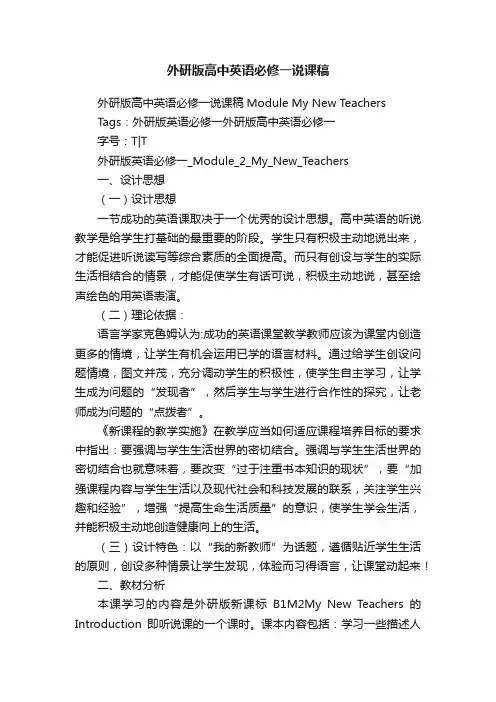
外研版高中英语必修一说课稿外研版高中英语必修一说课稿Module My New TeachersTags:外研版英语必修一外研版高中英语必修一字号:T|T外研版英语必修一_Module_2_My_New_Teachers一、设计思想(一)设计思想一节成功的英语课取决于一个优秀的设计思想。
高中英语的听说教学是给学生打基础的最重要的阶段。
学生只有积极主动地说出来,才能促进听说读写等综合素质的全面提高。
而只有创设与学生的实际生活相结合的情景,才能促使学生有话可说,积极主动地说,甚至绘声绘色的用英语表演。
(二)理论依据:语言学家克鲁姆认为:成功的英语课堂教学教师应该为课堂内创造更多的情境,让学生有机会运用已学的语言材料。
通过给学生创设问题情境,图文并茂,充分调动学生的积极性,使学生自主学习,让学生成为问题的“发现者”,然后学生与学生进行合作性的探究,让老师成为问题的“点拨者”。
《新课程的教学实施》在教学应当如何适应课程培养目标的要求中指出:要强调与学生生活世界的密切结合。
强调与学生生活世界的密切结合也就意味着,要改变“过于注重书本知识的现状”,要“加强课程内容与学生生活以及现代社会和科技发展的联系,关注学生兴趣和经验”,增强“提高生命生活质量”的意识,使学生学会生活,并能积极主动地创造健康向上的生活。
(三)设计特色:以“我的新教师”为话题,遵循贴近学生生活的原则,创设多种情景让学生发现,体验而习得语言,让课堂动起来!二、教材分析本课学习的内容是外研版新课标B1M2My New Teachers的Introduction即听说课的一个课时。
课本内容包括:学习一些描述人物的形容词;学习用这些形容词描述自己熟悉的人物;讨论并描述自己心目中的好老师;听一名英国男孩对好老师的理解并与自己的描述比较。
考虑到教学内容较少而且比较单一,不能充分调动学生的积极性,达到听说课的教学目的,我结合学生的实际生活,对教材整个模块的内容进行了整合,通过创设多种情景活动,使学生积极参与课堂活动,主动踊跃地发言,并且惟妙惟肖地表演。
高中英语学习材料(灿若寒星*制作整理)Unit1 My First Day at Senior High 说课稿一.教材分析My First Day at Senior High是外研社出版的高中英语教材中,高一课程的第一个单元。
这是一个基础单元,是学生有初中过渡都高中,学习英语的第一个单元。
此单元不仅旨在让学生学到知识,并且要引起学生学习英语的兴趣,为整个高中英语教学,打下第一步的基础。
而阅读能力一直都是学生必备的英语能力之一,因此这个单元的阅读课是相当基础,也是重要的。
文中介绍一位高中新生第一天到校观察和接触到的人和事物以及个人的感受,内容紧密结合学生的现实生活,能充分激发学生兴趣,引起共鸣。
二.教学目标1.知识目标掌握文中出现的固定搭配,短语和习惯用法●And we have fun. Fun is an uncountable noun. We usually use “a lot of” modified it.A lot of fun●Ms Shen gave us instructions and then we worked by ourselves.●By oneself 单独地,独自地●In other words 换句话说●There are three times as many as girls as boys.As……as…… ……和……一样,前面可加修饰成分,这里加了three times●They say that…… 据说……2.能力目标通过对文章的阅读和理解,了解并掌握一些阅读技巧,如skimming,scanning.3.情感目标通过pair works,group discuss等方式,培养学生独立思考,团结互助的精神,同时也培养学生的语言表达能力,逐步使他们能自信地,勇敢地在同学(大众面前)表达自己的感想和意见。
三.教学重、难点重点:对文章主旨大意的理解,对文中规定搭配,习惯用语,描写感受的词汇的掌握。
Good afternoon, teachers! It’s my great pleasure to be here to share my lesson with you. Today my topic is Module 1 My first day at Senior High. It’s from New Standard English for students’ book 1. I’d like divide my speech into 5 parts: the analysis of the teaching material, the analysis of the students, the teaching methods, the teaching procedures and blackboard design.Part1 The analysis of the teaching materialThis lesson is a reading text, and it’s about a student’s first day at senior high, such a topic is related to our daily life, so it’s easy to arouse the students’ learning interests. My teaching aims include 3 aims.First one: knowledge aims: help students learn the new words, phrases and sentences. Second one: ability aims: develop the student’ abilities of reading, and train their abilities of studying by themselves and working in pairs or groups.Third one: emotional aims: develop the students’ teamwork spirit and set up their self-confidence in English learning.And in this lesson, the important points are mastering the usage of some important words and sentence patterns, such as, look forward to, far away.The difficult point is how to use what they have learned in real situation.Part2 The analysis of the studentsMy students have learned English for 7 years. They can understand some words and simple sentences. They are active, interested in new things and like competition. They like learning through working in pairs or groups. But they always have little chance to speak English. So, I’d like to make more chances for them to speak in class.Part3 Teaching methods and learning methodsIn this lesson, I will use: communicative approach, task-based language teaching. As for learning methods, the students can work in pairs or groups.Part 4 Teaching proceduresIn this part, there are six steps.Step1 Lead-in(3mins)I will say hello to students and ask them to talk about their first day at senior high, and then share with us. My purpose is to arouse the students in this lesson.Step2 Pre-reading(10mins)Do a guessing game. Show some funny pictures and sentence on PPT and then ask the students to guess the meaning of the new words. By doing this, I want to arouse students learning interests, and help them to learn the new words and phrases which is good for the following learning.Step3 While-reading(15mins)There are two activities for the students.Activity one, fast reading: I will let students read the passage as quickly as they can to find out the main idea and then do some exercises in the book. This can help students get the general idea of the passage.Activity two, careful reading: Let students read the passage carefully, take some important notes and then discuss in pairs to fill in the table, make an outline of the article, find the topic sentences of each paragraphs. My purpose is to develop students’ reading ability.Fast reading is for the general idea, and careful reading is for details, and help students get a better understanding of the passage.Step4 Post-reading(10mins)I will divide the students into several groups, and show some key words on the PPT, then ask students to discuss their first day at senior high. From this part, students can develop their teamwork spirit and set up their self-confidence in speaking English. Step5 Summary(5mins)I will ask students to share what they have talked in this class by themselves. In my opinion, this can help students review what they have learned in time.Step6 Homework(2mins)I’d like to give the students different homework. All of them will write a composition according to their discussion, and some of them could get more material about this topic and then write a report. My purpose is to develop the students writing ability. I think homework is an extension of class, and it is good for the students to learn the next lesson.Part5 Blackboard designI’ll divide the blackboard into two parts. The left part will be used to write the important words and phrases, and the right part is used to write sentences.That’s all for my teaching design. Thanks a lot for your attention.。
1教学目标eaching Goals:1. To arouse Ss’ interest in learning about Europe.2. To get Ss to learn words and phrases to describe location2学情分析1. Ask Ss to finish the following activities in pairs.(1) let Ss give as many European countries as they can and write the names of t he countries on the blackboard.(2) Let Ss give as many European cities as they can and write the names of the cities on the blackboard too.(3) Match the countries with the cities.3重点难点Germany : Frankfurt, Essen, Bremen, MunichFrance: Paris, Momaco, Lyon, StrasbourgItaly: Rome, NaplesBritain: Glasgow, Manchester, Birmingham, London, BelfastPoland: Warsaw, wroclaw4教学过程4.1第一学时教学活动1【导入】pair work team worka. Remind the students of the expressions to keep the conversation going.b. Ask the students to read the dialogue individually.c. Listen to the tape and ask the students to repeat.d. Put the students into pairs to practise the conversation.e. Make up a conversation: put the students into pairs and give them some time t o make up conversations and practise them. (训练学生对新知识的运用能力)Step 5. Homework Revise the knowledge learned today and preview Reading and Vocabulary .(从课堂教学的策略来讲,本堂课听说读写并举,旨在突出语言交际能力的培养,并为接下来的课堂教学内容做好铺垫。
必修一unit1 High School Hints说课稿Good morning, everyone! It's my honor to stand here and share my teaching ideas with you. My presentation is High School Hints.The analysis of teaching materialThe reading passage is a interview. It's about how to adapt senior high school life. The students can get some useful advice to help them adapt new life quickly. It's close to life and easy to understand.Teaching aims:1.Knowledge aims:Enable the students to master the key words and expressions.2.Ability aims:Enable the students to guess the content of the passage according to the title. And get main Information by scheming and scanning.3.Emotional aims:Encourage the students to face the challenges with positive attitude.Important points:1.Master the key words and expressions.2.Grasp different reading skills such as skimming and scanning.Difficult points:1.Developed students reading skills.2.Understand the implied meanings of the words.Teaching methods:1.Task based teaching method. It can help the students to understand the passage better.2.Situation of teaching method. Create a suitable language situation is important to arouse the students interest.Studying ways:Group teaching method. Divided students into several groups. In the group they will help each other learn by reading speaking, cooperating and discussing.Teaching procedures:Step one Warming upShow some pictures about school activities such as joining a club, take a trip with your classmates, stand on stage and so on. Then ask the students to think about the things they want to achieve at high school and rank them in order of importance.Step two Lead inT: How do you achieve these goals? If you meet some difficulties, what should you do? The interview will provide some help. Before reading, you can predict what is talked about in the interview. Now read the interview and check your prediction.Step three ScanningScanned interview and answered questions on page 10. It can help students find a specific piece of Information.Step four Careful readingRead the passage carefully and choose the words and expressions you can't understand. Discuss them with your group numbers to guess their meanings. Discuss them with your group members to guess their meanings. Then the teacher explain the rest. Read again and Complete the chart about problems and advice.Step five ConsolidationGive a speech to the new students on their first day at high school. As a new student, do you have any other problems? You can discuss them with your group members and get some advice from them. Then make notes of the problems the new students may face and advice.Step six SummaryDraw a mind map about the passage to help the students retell the passage.Blackboard design:How to know about the school quickly.Problems and new How to deal with challenges.students may face How to deal with this appointment. Interview How to get on with others.Take part in Orientation Day.Advice Go all outKeep working hardGive your friends a handThat's all. Thanks for listening!。